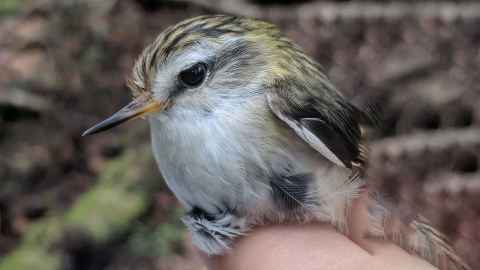Young ecologists discover fearsome predator of NZ’s tiniest bird
25 June 2019
Two University of Auckland PhD students have discovered New Zealand’s smallest bird has a fearsome predator, the long-tailed cuckoo, something scientists hadn’t known until now.

School of Biological Sciences researchers Ines Moran and Yen Yi Loo made the discovery during a field study investigating behaviour and vocalisation of the tiny endemic rifleman or tītipounamu (Acanthisitta chloris).
Checking footage to make sure the field camera traps were working properly, the researchers got a big surprise to see a long-tailed cuckoo or koekoeā (Eudynamys taitensis) snatching tiny rifleman chicks from the nest, something never documented by scientists before.
“Our work is focused on studying rifleman behaviour and interaction between parents and chicks so when I saw the cuckoo footage, it came as something of a shock,” says Ms Moran. “It’s quite unique to discover a new predator of an endemic bird and cuckoos were not on the predator list for rifleman – well not until now anyway.”
Cuckoos are notorious for laying their eggs in other birds’ nests but the revelation that cuckoos are attacking rifleman fledglings is bad news for the tiny birds which are classified as ‘at risk, in decline’ by the Department of Conservation.
“Now we have evidence long-tailed cuckoo are a rifleman predator, we need to do further research,” says Yen Yi Loo, “including whether cuckoos are also laying eggs in rifleman nests and how often nests are being abandoned as a result.”
The rifleman weighs in at just 5-7g and is one of two surviving members of the wren family, which originally included seven species. The birds have been translocated to off-shore islands to help boost population numbers.
Rifleman live in social groups and are monogamous, staying in the same pair until one partner dies. Both male and female help raise chicks but the birds also have a communal approach to parenting, getting help with parenting from single, unrelated birds within the group.
The long-tailed cuckoo (Eudynamys taitensis) is a summer migrant to New Zealand and, like all members of the cuckoo family, is a brood parasite, meaning it lays its eggs in other birds’ nests. It breeds throughout New Zealand from October to March so its breeding season overlaps that of a range of smaller bird species. In New Zealand, it lays eggs in the nests of pōpokotea (Mohoua albicilla), yellowheads or mohua (Mohoua ochrocephala) and brown creepers (pipipi) (Mohoua novaeseelandiae).
The study is published in Notornis and was funded by the Marsden Fund and the University of Auckland.
Media contact
Anne Beston | Media adviser
DDI 09 923 3258
Mob 021 970 089
Email a.beston@auckland.ac.nz